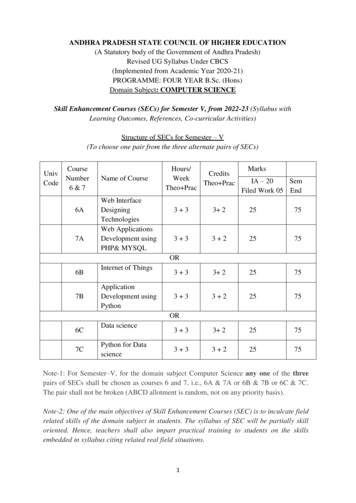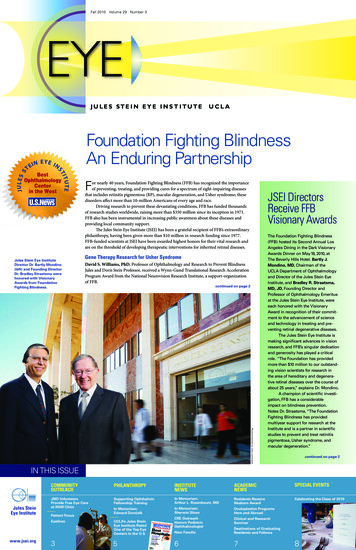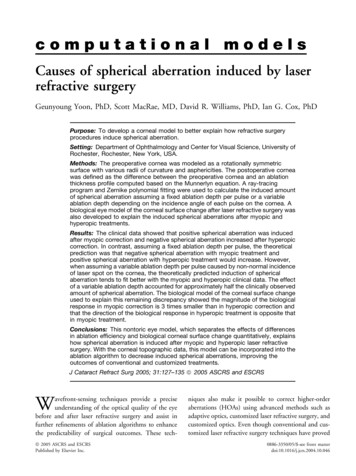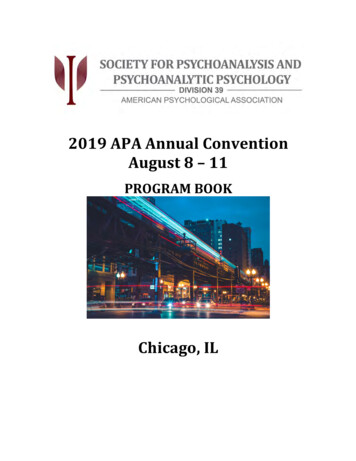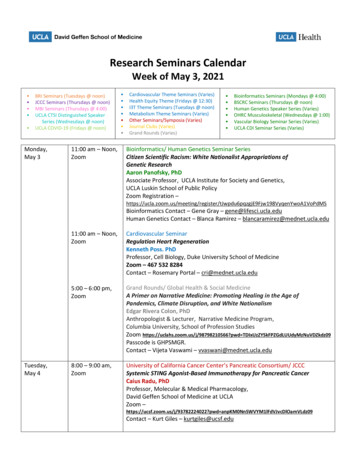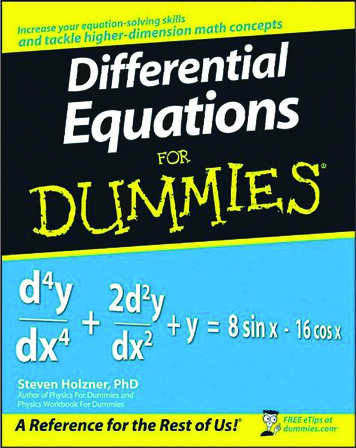
Transcription
DifferentialEquationsFORDUMmIES‰by Steven Holzner, PhD
DifferentialEquationsFORDUMmIES‰
DifferentialEquationsFORDUMmIES‰by Steven Holzner, PhD
Differential Equations For Dummies Published byWiley Publishing, Inc.111 River St.Hoboken, NJ 07030-5774www.wiley.comCopyright 2008 by Wiley Publishing, Inc., Indianapolis, IndianaPublished simultaneously in CanadaNo part of this publication may be reproduced, stored in a retrieval system, or transmitted in any formor by any means, electronic, mechanical, photocopying, recording, scanning, or otherwise, except as permitted under Sections 107 or 108 of the 1976 United States Copyright Act, without either the prior writtenpermission of the Publisher, or authorization through payment of the appropriate per-copy fee to theCopyright Clearance Center, 222 Rosewood Drive, Danvers, MA 01923, 978-750-8400, fax 978-646-8600.Requests to the Publisher for permission should be addressed to the Legal Department, Wiley Publishing,Inc., 10475 Crosspoint Blvd., Indianapolis, IN 46256, 317-572-3447, fax 317-572-4355, or online athttp://www.wiley.com/go/permissions.Trademarks: Wiley, the Wiley Publishing logo, For Dummies, the Dummies Man logo, A Reference for theRest of Us!, The Dummies Way, Dummies Daily, The Fun and Easy Way, Dummies.com and related tradedress are trademarks or registered trademarks of John Wiley & Sons, Inc. and/or its affiliates in the UnitedStates and other countries, and may not be used without written permission. All other trademarks are theproperty of their respective owners. Wiley Publishing, Inc., is not associated with any product or vendormentioned in this book.LIMIT OF LIABILITY/DISCLAIMER OF WARRANTY: THE PUBLISHER AND THE AUTHOR MAKE NO REPRESENTATIONS OR WARRANTIES WITH RESPECT TO THE ACCURACY OR COMPLETENESS OF THE CONTENTS OF THIS WORK AND SPECIFICALLY DISCLAIM ALL WARRANTIES, INCLUDING WITHOUTLIMITATION WARRANTIES OF FITNESS FOR A PARTICULAR PURPOSE. NO WARRANTY MAY BE CREATED OR EXTENDED BY SALES OR PROMOTIONAL MATERIALS. THE ADVICE AND STRATEGIES CONTAINED HEREIN MAY NOT BE SUITABLE FOR EVERY SITUATION. THIS WORK IS SOLD WITH THEUNDERSTANDING THAT THE PUBLISHER IS NOT ENGAGED IN RENDERING LEGAL, ACCOUNTING, OROTHER PROFESSIONAL SERVICES. IF PROFESSIONAL ASSISTANCE IS REQUIRED, THE SERVICES OF ACOMPETENT PROFESSIONAL PERSON SHOULD BE SOUGHT. NEITHER THE PUBLISHER NOR THEAUTHOR SHALL BE LIABLE FOR DAMAGES ARISING HEREFROM. THE FACT THAT AN ORGANIZATIONOR WEBSITE IS REFERRED TO IN THIS WORK AS A CITATION AND/OR A POTENTIAL SOURCE OF FURTHER INFORMATION DOES NOT MEAN THAT THE AUTHOR OR THE PUBLISHER ENDORSES THE INFORMATION THE ORGANIZATION OR WEBSITE MAY PROVIDE OR RECOMMENDATIONS IT MAY MAKE.FURTHER, READERS SHOULD BE AWARE THAT INTERNET WEBSITES LISTED IN THIS WORK MAY HAVECHANGED OR DISAPPEARED BETWEEN WHEN THIS WORK WAS WRITTEN AND WHEN IT IS READ.For general information on our other products and services, please contact our Customer CareDepartment within the U.S. at 800-762-2974, outside the U.S. at 317-572-3993, or fax 317-572-4002.For technical support, please visit www.wiley.com/techsupport.Wiley also publishes its books in a variety of electronic formats. Some content that appears in print maynot be available in electronic books.Library of Congress Control Number: 2008925781ISBN: 978-0-470-17814-0Manufactured in the United States of America10 9 8 7 6 5 4 3 2 1
About the AuthorSteven Holzner is an award-winning author of science, math, and technicalbooks. He got his training in differential equations at MIT and at CornellUniversity, where he got his PhD. He has been on the faculty at both MIT andCornell University, and has written such bestsellers as Physics For Dummiesand Physics Workbook For Dummies.
DedicationTo Nancy, always and forever.Author’s AcknowledgmentsThe book you hold in your hands is the work of many people. I’d especiallylike to thank Tracy Boggier, Georgette Beatty, Jessica Smith, technicalreviewer Jamie Song, PhD, and the folks in Composition Services who put thebook together so beautifully.
Publisher’s AcknowledgmentsWe’re proud of this book; please send us your comments through our Dummies online registrationform located at www.dummies.com/register/.Some of the people who helped bring this book to market include the following:Acquisitions, Editorial, andMedia DevelopmentProject Editor: Georgette BeattyComposition ServicesProject Coordinator: Erin SmithAcquisitions Editor: Tracy BoggierLayout and Graphics: Carrie A. Cesavice,Stephanie D. JumperCopy Editor: Jessica SmithProofreaders: Caitie Kelly, Linda D. MorrisEditorial Program Coordinator:Erin Calligan MooneyIndexer: Broccoli Information ManagementTechnical Editor: Jamie Song, PhDEditorial Manager: Michelle HackerEditorial Assistants: Joe Niesen, Leeann HarneyCartoons: Rich Tennant(www.the5thwave.com)Publishing and Editorial for Consumer DummiesDiane Graves Steele, Vice President and Publisher, Consumer DummiesJoyce Pepple, Acquisitions Director, Consumer DummiesKristin A. Cocks, Product Development Director, Consumer DummiesMichael Spring, Vice President and Publisher, TravelKelly Regan, Editorial Director, TravelPublishing for Technology DummiesAndy Cummings, Vice President and Publisher, Dummies Technology/General UserComposition ServicesGerry Fahey, Vice President of Production ServicesDebbie Stailey, Director of Composition Services
Contents at a GlanceIntroduction .1Part I: Focusing on First Order Differential Equations.5Chapter 1: Welcome to the World of Differential Equations .7Chapter 2: Looking at Linear First Order Differential Equations.23Chapter 3: Sorting Out Separable First Order Differential Equations.41Chapter 4: Exploring Exact First Order Differential Equationsand Euler’s Method.63Part II: Surveying Second and Higher OrderDifferential Equations .89Chapter 5: Examining Second Order Linear HomogeneousDifferential Equations.91Chapter 6: Studying Second Order Linear NonhomogeneousDifferential Equations.123Chapter 7: Handling Higher Order Linear Homogeneous DifferentialEquations .151Chapter 8: Taking On Higher Order Linear NonhomogeneousDifferential Equations.173Part III: The Power Stuff: Advanced Techniques .189Chapter 9: Getting Serious with Power Series and Ordinary Points.191Chapter 10: Powering through Singular Points .213Chapter 11: Working with Laplace Transforms .239Chapter 12: Tackling Systems of First Order Linear Differential Equations .265Chapter 13: Discovering Three Fail-Proof Numerical Methods .293Part IV: The Part of Tens .315Chapter 14: Ten Super-Helpful Online Differential Equation Tutorials.317Chapter 15: Ten Really Cool Online Differential Equation Solving Tools .321Index .325
Table of ContentsIntroduction.1About This Book.1Conventions Used in This Book .1What You’re Not to Read.2Foolish Assumptions .2How This Book Is Organized.2Part I: Focusing on First Order Differential Equations.3Part II: Surveying Second and Higher OrderDifferential Equations.3Part III: The Power Stuff: Advanced Techniques .3Part IV: The Part of Tens.3Icons Used in This Book.4Where to Go from Here.4Part I: Focusing on First Order Differential Equations .5Chapter 1: Welcome to the World of Differential Equations . . . . . . . . .7The Essence of Differential Equations.8Derivatives: The Foundation of Differential Equations .11Derivatives that are constants.11Derivatives that are powers.12Derivatives involving trigonometry .12Derivatives involving multiple functions .12Seeing the Big Picture with Direction Fields.13Plotting a direction field .13Connecting slopes into an integral curve .14Recognizing the equilibrium value.16Classifying Differential Equations .17Classifying equations by order .17Classifying ordinary versus partial equations.17Classifying linear versus nonlinear equations.18Solving First Order Differential Equations .19Tackling Second Order and Higher Order Differential Equations .20Having Fun with Advanced Techniques .21
xiiDifferential Equations For DummiesChapter 2: Looking at Linear First Order Differential Equations . . . . .23First Things First: The Basics of Solving Linear First OrderDifferential Equations .24Applying initial conditions from the start.24Stepping up to solving differentialequations involving functions.25Adding a couple of constants to the mix.26Solving Linear First Order Differential Equationswith Integrating Factors .26Solving for an integrating factor.27Using an integrating factor to solve a differential equation .28Moving on up: Using integrating factors in differentialequations with functions .29Trying a special shortcut .30Solving an advanced example.32Determining Whether a Solution for a Linear First OrderEquation Exists .35Spelling out the existence and uniqueness theoremfor linear differential equations .35Finding the general solution .36Checking out some existence and uniqueness examples .37Figuring Out Whether a Solution for a NonlinearDifferential Equation Exists.38The existence and uniqueness theorem fornonlinear differential equations.39A couple of nonlinear existence and uniqueness examples .39Chapter 3: Sorting Out Separable First OrderDifferential Equations . . . . . . . . . . . . . . . . . . . . . . . . . . . . . . . . . . . . . . . . .41Beginning with the Basics of Separable Differential Equations .42Starting easy: Linear separable equations .43Introducing implicit solutions .43Finding explicit solutions from implicit solutions .45Tough to crack: When you can’t find an explicit solution .48A neat trick: Turning nonlinear separable equations intolinear separable equations .49Trying Out Some Real World Separable Equations.52Getting in control with a sample flow problem .52Striking it rich with a sample monetary problem .55Break It Up! Using Partial Fractions in Separable Equations.59
Table of ContentsChapter 4: Exploring Exact First Order DifferentialEquations and Euler’s Method . . . . . . . . . . . . . . . . . . . . . . . . . . . . . . . . . .63Exploring the Basics of Exact Differential Equations .63Defining exact differential equations .64Working out a typical exact differential equation .65Determining Whether a Differential Equation Is Exact.66Checking out a useful theorem .66Applying the theorem .67Conquering Nonexact Differential Equationswith Integrating Factors .70Finding an integrating factor.71Using an integrating factor to get an exact equation.73The finishing touch: Solving the exact equation .74Getting Numerical with Euler’s Method .75Understanding the method .76Checking the method’s accuracy on a computer.77Delving into Difference Equations.83Some handy terminology .84Iterative solutions .84Equilibrium solutions .85Part II: Surveying Second and Higher OrderDifferential Equations.89Chapter 5: Examining Second Order LinearHomogeneous Differential Equations . . . . . . . . . . . . . . . . . . . . . . . . . . .91The Basics of Second Order Differential Equations.91Linear equations.92Homogeneous equations.93Second Order Linear Homogeneous Equationswith Constant Coefficients .94Elementary solutions .94Initial conditions.95Checking Out Characteristic Equations .96Real and distinct roots.97Complex roots.100Identical real roots .106Getting a Second Solution by Reduction of Order .109Seeing how reduction of order works.110Trying out an example .111xiii
xivDifferential Equations For DummiesPutting Everything Together with Some Handy Theorems .114Superposition.114Linear independence .115The Wronskian .117Chapter 6: Studying Second Order Linear NonhomogeneousDifferential Equations . . . . . . . . . . . . . . . . . . . . . . . . . . . . . . . . . . . . . . . .123The General Solution of Second Order LinearNonhomogeneous Equations .124Understanding an important theorem.124Putting the theorem to work.125Finding Particular Solutions with the Method ofUndetermined Coefficients.127When g(x) is in the form of erx .127When g(x) is a polynomial of order n .128When g(x) is a combination of sines and cosines .131When g(x) is a product of two different forms .133Breaking Down Equations with the Variation of Parameters Method .135Nailing down the basics of the method .136Solving a typical example.137Applying the method to any linear equation .138What a pair! The variation of parameters methodmeets the Wronskian.142Bouncing Around with Springs ’n’ Things .143A mass without friction .144A mass with drag force .148Chapter 7: Handling Higher Order Linear HomogeneousDifferential Equations . . . . . . . . . . . . . . . . . . . . . . . . . . . . . . . . . . . . . . . .151The Write Stuff: The Notation of Higher OrderDifferential Equations .152Introducing the Basics of Higher Order LinearHomogeneous Equations.153The format, solutions, and initial conditions .153A couple of cool theorems .155Tackling Different Types of Higher Order LinearHomogeneous Equations.156Real and distinct roots.156Real and imaginary roots .161Complex roots.164Duplicate roots .166
Table of ContentsChapter 8: Taking On Higher Order Linear NonhomogeneousDifferential Equations . . . . . . . . . . . . . . . . . . . . . . . . . . . . . . . . . . . . . . . .173Mastering the Method of Undetermined Coefficientsfor Higher Order Equations.174When g(x) is in the form erx .176When g(x) is a polynomial of order n .179When g(x) is a combination of sines and cosines .182Solving Higher Order Equations with Variation of Parameters.185The basics of the method.185Working through an example.186Part III: The Power Stuff: Advanced Techniques.189Chapter 9: Getting Serious with Power Seriesand Ordinary Points . . . . . . . . . . . . . . . . . . . . . . . . . . . . . . . . . . . . . . . . . .191Perusing the Basics of Power Series.191Determining Whether a Power Series Convergeswith the Ratio Test .192The fundamentals of the ratio test.192Plugging in some numbers .193Shifting the Series Index.195Taking a Look at the Taylor Series .195Solving Second Order Differential Equations with Power Series .196When you already know the solution .198When you don’t know the solution beforehand .204A famous problem: Airy’s equation.207Chapter 10: Powering through Singular Points . . . . . . . . . . . . . . . . . .213Pointing Out the Basics of Singular Points .213Finding singular points .214The behavior of singular points .214Regular versus irregular singular points.215Exploring Exciting Euler Equations .219Real and distinct roots.220Real and equal roots .222Complex roots.223Putting it all together with a theorem.224Figuring Series Solutions Near Regular Singular Points.225Identifying the general solution.225The basics of solving equations near singular points .227A numerical example of solving an equationnear singular points.230Taking a closer look at indicial equations.235xv
xviDifferential Equations For DummiesChapter 11: Working with Laplace Transforms . . . . . . . . . . . . . . . . . .239Breaking Down a Typical Laplace Transform.239Deciding Whether a Laplace Transform Converges .240Calculating Basic Laplace Transforms .241The transform of 1.242The transform of eat .242The transform of sin at .242Consulting a handy table for some relief .244Solving Differential Equations with Laplace Transforms .245A few theorems to send you on your way.246Solving a second order homogeneous equation .247Solving a second order nonhomogeneous equation .251Solving a higher order equation .255Factoring Laplace Transforms and Convolution Integrals .258Factoring a Laplace transform into fractions .258Checking out convolution integrals .259Surveying Step Functions.261Defining the step function .261Figuring the Laplace transform of the step function .262Chapter 12: Tackling Systems of First Order LinearDifferential Equations . . . . . . . . . . . . . . . . . . . . . . . . . . . . . . . . . . . . . . . .265Introducing the Basics of Matrices .266Setting up a matrix .266Working through the algebra .267Examining matrices.268Mastering Matrix Operations.269Equality.269Addition .270Subtraction.270Multiplication of a matrix and a number.270Multiplication of two matrices.270Multiplication of a matrix and a vector .271Identity.272The inverse of a matrix.272Having Fun with Eigenvectors ’n’ Things.278Linear independence .278Eigenvalues and eigenvectors .281Solving Systems of First-Order Linear HomogeneousDifferential Equations .283Understanding the basics.284Making your way through an example .285Solving Systems of First Order Linear Nonhomogeneous Equations .288Assuming the correct form of the particular solution.289Crunching the numbers.290Winding up your work .292
Table of ContentsChapter 13: Discovering Three Fail-Proof Numerical Methods . . . . .293Number Crunching with Euler’s Method .294The fundamentals of the method .294Using code to see the method in action .295Moving On Up with the Improved Euler’s Method .299Understanding the improvements .300Coming up with new code .300Plugging a steep slope into the new code .304Adding Even More Precision with the Runge-Kutta Method .308The method’s recurrence relation.308Working with the method in code .309Part IV: The Part of Tens .315Chapter 14: Ten Super-Helpful Online DifferentialEquation Tutorials . . . . . . . . . . . . . . . . . . . . . . . . . . . . . . . . . . . . . . . . . . .317AnalyzeMath.com’s Introduction to Differential Equations .317Harvey Mudd College Mathematics Online Tutorial .318John Appleby’s Introduction to Differential Equations.318Kardi Teknomo’s Page .318Martin J. Osborne’s Differential Equation Tutorial.318Midnight Tutor’s Video Tutorial.319The Ohio State University Physics Department’sIntroduction to Differential Equations.319Paul’s Online Math Notes .319S.O.S. Math .319University of Surrey Tutorial .320Chapter 15: Ten Really Cool Online DifferentialEquation Solving Tools . . . . .
Wiley also publishes its books in a variety of electronic formats. Some content that appears in print may not be available in electronic books. Library of Congress Control Number: 2008925781 ISBN: 978-0-470-17814-0 Manufactured in the United States of America 10 9 8 7

